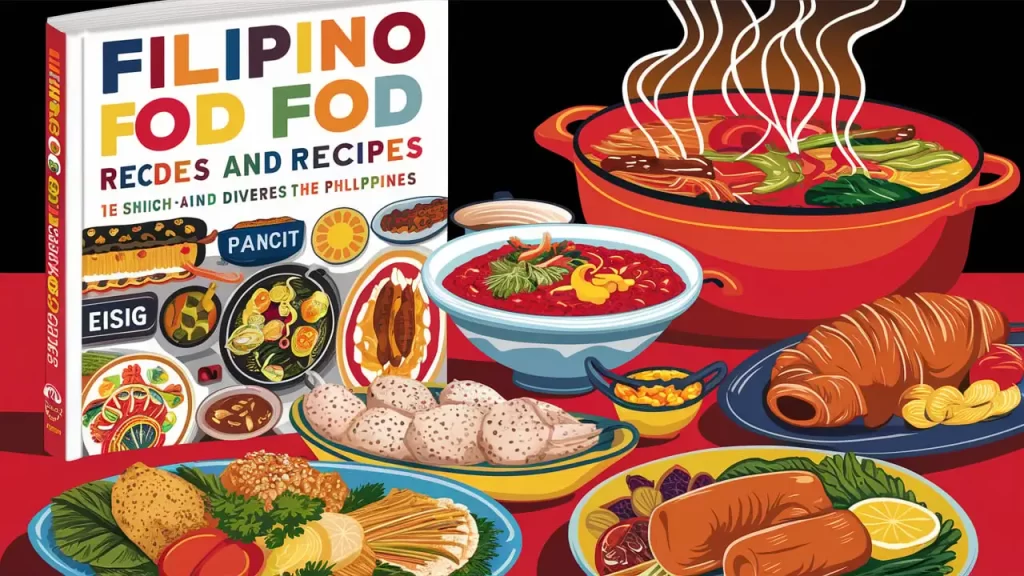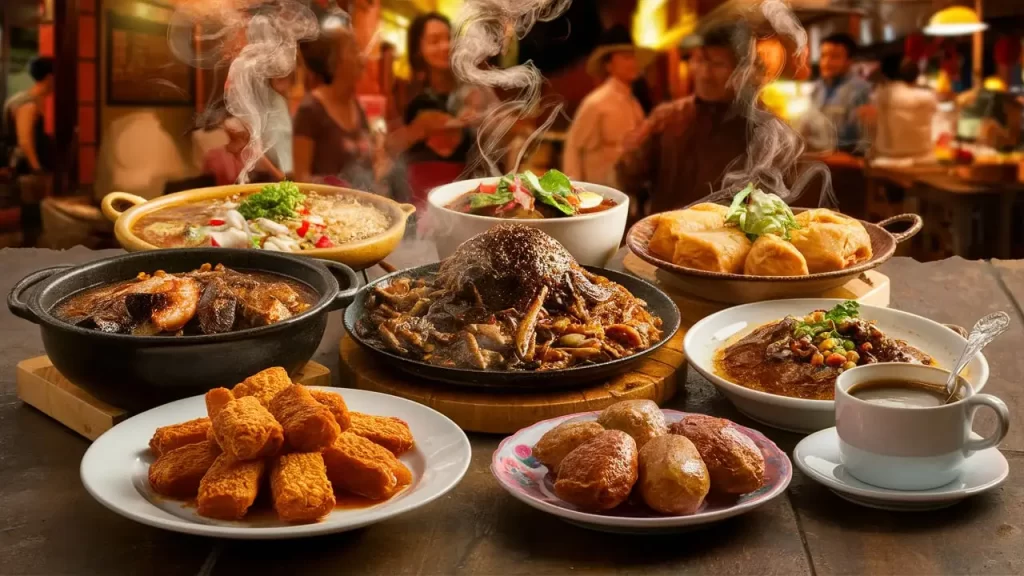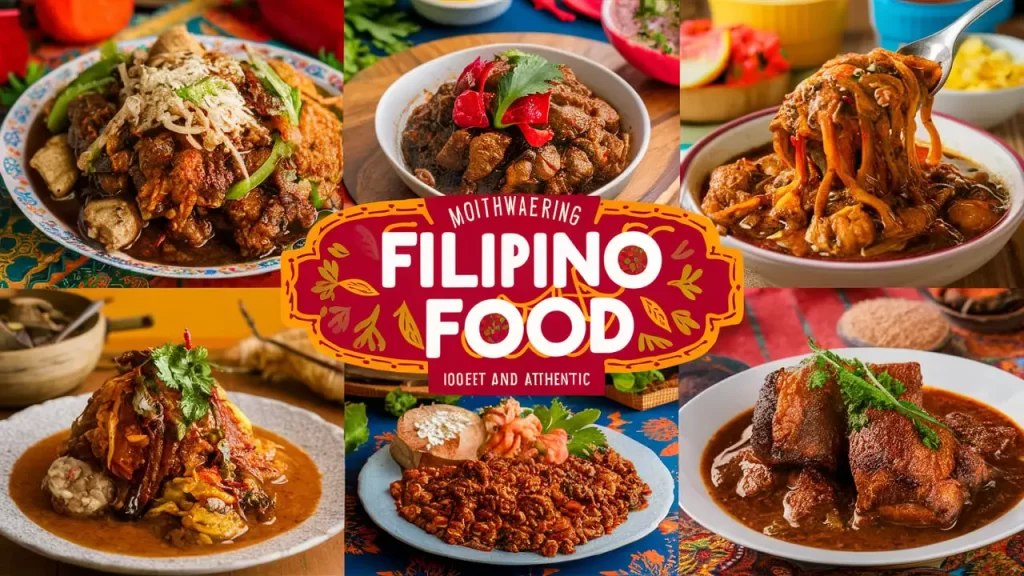Filipino food recipes offer a unique blend of flavours that are irresistible and authentic. From savoury meats to sweet desserts, Filipino cuisine has something for everyone. This article will guide you through some of the most beloved Filipino dishes, providing recipes and tips to bring the taste of the Philippines to your kitchen. By the end of this journey, you’ll have a deeper appreciation for Filipino food and the joy it brings to those who savour it.
The Essence of Filipino Food

A Melting Pot of Flavors
Filipino food recipes are a reflection of the country’s rich history and diverse culture. Influences from Malay, Chinese, Spanish, and American cuisines have melded together to create a unique culinary tradition. This fusion is evident in the variety of flavours found in Filipino dishes, which often combine sweet, salty, sour, and spicy elements.
Key Ingredients
Essential ingredients in Filipino food recipes include garlic, onions, ginger, soy sauce, vinegar, and coconut milk. These staples provide the foundation for many dishes and contribute to the distinct taste of Filipino cuisine. Fresh herbs like pandan and calamansi also add unique flavours that set Filipino dishes apart from other cuisines.
Classic Filipino Food Recipes
Adobo: The National Dish
Adobo is one of the most famous Filipino food recipes. This savoury dish is made by marinating meat (usually chicken or pork) in a mixture of soy sauce, vinegar, garlic, bay leaves, and black peppercorns. The marinated meat is then simmered until tender, creating a flavorful and aromatic meal.
Ingredients:
- 1 kg chicken or pork
- 1/2 cup soy sauce
- 1/2 cup vinegar
- 6 cloves garlic, minced
- 2 bay leaves
- 1 tsp black peppercorns
- 1 cup water
- 2 tbsp cooking oil
Instructions:
- In a bowl, combine soy sauce, vinegar, garlic, bay leaves, and peppercorns.
- Add the meat, and let it marinate for one hour or longer.
- Heat oil in a pan over medium heat. After adding, cook the marinated meat until browned.
- Pour in the marinade and water. Bring to a boil, then simmer for 30-40 minutes until the meat is tender and the sauce thickens.
- Serve hot with steamed rice.
Sinigang: A Comforting Sour Soup

Sinigang is a beloved Filipino soup known for its sour and savoury taste. It is traditionally made with pork, shrimp, or fish and flavoured with tamarind, tomatoes, and various vegetables like kangkong (water spinach) and radish.
Ingredients:
- 1 kg pork belly or ribs
- 1 onion, sliced
- 2 tomatoes, quartered
- 1 radish, sliced
- 1 eggplant, sliced
- 2 cups kangkong leaves
- 1 pack sinigang mix or fresh tamarind
- 1 liter water
- Fish sauce to taste
Instructions:
- In a pot, boil water and add the pork. Cook until tender.
- Add the onion and tomatoes. Simmer for 10 minutes.
- Add the radish and eggplant. Cook until the vegetables are tender.
- Stir in the sinigang mix or fresh tamarind.
- Add the kangkong leaves and cook for another 2 minutes.
- Season with fish sauce to taste. Serve hot with steamed rice.
Lechon Kawali: Crispy Fried Pork Belly
Lechon Kawali is a crispy fried pork belly that is a favourite at Filipino celebrations. The pork is boiled until tender, then deep-fried to achieve a crispy exterior and juicy interior.
Ingredients:
- 1 kg pork belly
- 1 tbsp salt
- 1 tsp peppercorns
- 3 bay leaves
- 4 cups water
- Cooking oil for frying
Instructions:
- In a pot, combine water, salt, peppercorns, and bay leaves. Bring to a boil.
- Add the pork belly and cook until tender, about 45 minutes.
- Remove the pork and let it cool. Pat dry with paper towels.
- Heat oil in a deep pan. Fry the pork belly until crispy and golden brown.
- Before slicing, give it a few minutes to rest. Accompany with vinegar dipping sauce or lechon sauce.
Sweet Endings: Filipino Desserts
Halo-Halo: A Festive Treat
Halo-Halo is a popular Filipino dessert that means “mix-mix” in English. It’s a delightful concoction of shaved ice, sweetened fruits, jellies, and beans and topped with leche flan and ube (purple yam) ice cream.
Ingredients:
- Shaved ice
- Sweetened red beans
- Sweetened garbanzo beans
- Nata de coco (coconut gel)
- Sweetened jackfruit
- Ube halaya (purple yam jam)
- Leche flan
- Ube ice cream
- Evaporated milk
Instructions:
- In a tall glass, layer the sweetened beans, nata de coco, and jackfruit.
- Add a generous amount of shaved ice on top.
- Drizzle with evaporated milk.
- Top with a spoonful of ube halaya, a slice of leche flan, and a scoop of ube ice cream.
- Mix well before eating, and enjoy!
Bibingka: Traditional Rice Cake
Bibingka is a Christmas-time favorite, a traditional rice cake from the Philippines. It is made from rice flour, coconut milk, and sugar and is baked with banana leaves for added aroma.
Ingredients:
- 1 cup rice flour
- 1 cup all-purpose flour
- 1 cup sugar
- 2 tsp baking powder
- 1/4 tsp salt
- 1 1/2 cups coconut milk
- 1/2 cup water
- 2 eggs, beaten
- Banana leaves
- Grated coconut and butter for topping
Instructions:
- Preheat the oven to 350°F (175°C). Banana leaf liner for a baking dish.
- Rice flour, all-purpose flour, sugar, baking powder, and salt should all be combined in a bowl.
- In another bowl, mix coconut milk, water, and eggs.
- Stirring to ensure complete blending, gradually incorporate the wet ingredients into the dry ingredients.
- Transfer the mixture into the baking dish that has been ready.
- When a toothpick is inserted in the center and comes out clean, the dish has been baking for 25 to 30 minutes.
- Top with grated coconut and butter. Serve warm.
Also Read: Famous Thai Food: Discover the Spicy Secrets & Rich Flavors
Final Thoughts
Filipino food recipes offer a delightful exploration of flavours and traditions that are both irresistible and authentic. From the savoury goodness of Adobo and Sinigang to the sweet indulgence of Halo-Halo and Bibingka, these dishes bring the essence of Filipino cuisine to your table. By incorporating these recipes into your cooking repertoire, you can savour the rich culinary heritage of the Philippines and share it with your loved ones.



